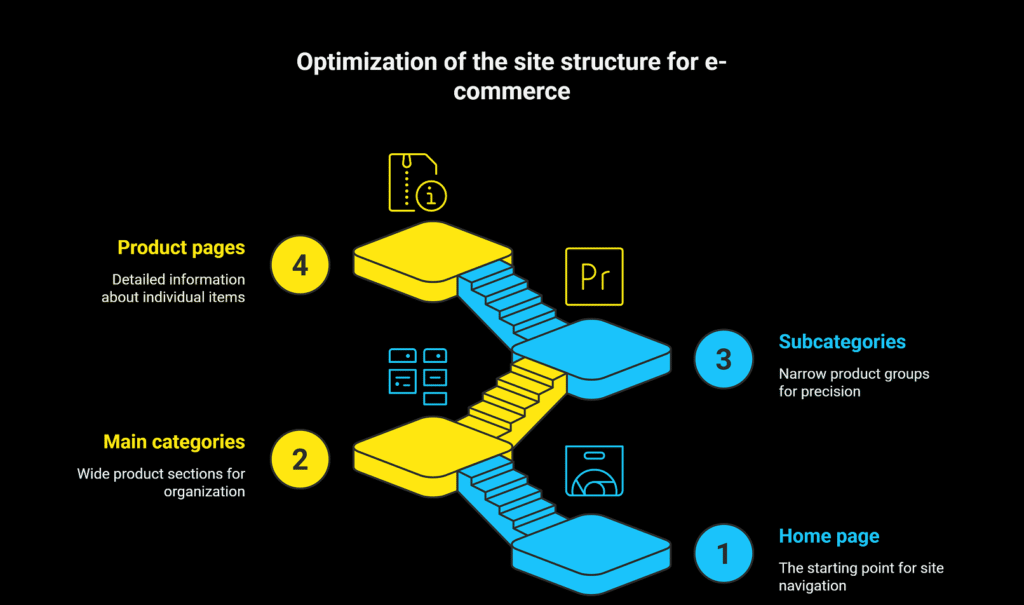Introduction: Why is SEO critical to the success of your online store?
In the digital age, having an online store is no longer a luxury but a necessity. However, just having an e-commerce site is not enough for success. Without adequate visibility on the Internet, your online store remains invisible to potential customers. That’s where SEO optimization comes in – a set of strategies and techniques that increase your site’s visibility on search engines like Google.
For e-commerce business owners in Novi Sad and Serbia, local SEO optimization represents a golden opportunity to attract a targeted audience. While the e-commerce market in Serbia is still developing, competition in Novi Sad and other major cities in Serbia is becoming increasingly intense. According to the latest data, over 70% of customers begin their shopping by searching the Internet, and more than 90% of them do not proceed to the next page of search results. This clearly shows why positioning your online store among the first search results is key to success.
SEO optimization for e-commerce sites has its own specifics compared to other types of sites. Online stores typically have hundreds or thousands of product pages, a complex category structure, and the need for regular updates. All this requires a special approach to SEO optimization, which we will cover in detail in this blog.
Basic components of an e-commerce SEO strategy
Keyword research for e-commerce
The foundation of any successful SEO strategy is quality keyword research. For online stores in Novi Sad, this research should include:
• Generic e-commerce terms (eg “online shopping”, “online store”)
• Specific terms for your niche (eg “online clothing store”, “buy electronics online”)
• Local terms (e.g. “e-commerce Novi Sad”, “online store Novi Sad”)
• Terms related to specific products (eg “Nike sneakers online shopping”)
It is important to focus on keywords with commercial intent, that is, those used by users ready to buy. Tools like Google Keyword Planner, Ahrefs or SEMrush can help you identify relevant keywords with good conversion potential.
Competition analysis
Studying competing e-commerce sites in Novi Sad can provide you with valuable insights for your strategy. It is important to analyze what keywords your competitors are using and how they have structured their category and product pages. Also pay attention to the types of content they post and where they get their links from.
This detailed analysis will help you identify opportunities and gaps that you can exploit in your SEO strategy. You may discover keywords that are underutilized by the competition or content topics that haven’t been covered yet.
Defining goals and KPIs
Before implementing an SEO strategy, it is important to define clear goals and key performance indicators (KPIs). For e-commerce sites, relevant KPIs include organic visibility for targeted keywords and the number of organic visits. It is also important to track the conversion rate from organic traffic and the average order value from organic traffic. Don’t forget the bounce rate which can indicate problems with the user experience.
Setting measurable goals will allow you to track the progress of your SEO strategy and adjust it as needed. Without clear goals, you won’t be able to assess whether your efforts are producing the desired results.
On-page SEO techniques for online stores
Site structure optimization
The structure of the e-commerce site should be logical, intuitive and optimized for search engines. A hierarchical structure is recommended that starts from the home page, continues through the main product categories, then subcategories, and finally comes to the individual product pages. This structure not only makes it easier for users to navigate, but also helps search engines better understand the organization of your site.
For online stores in Novi Sad, it is important that the structure of the site reflects the local context, especially if you offer delivery or pickup services in certain parts of the city. Consider creating special pages for local services you offer, such as free delivery for certain parts of Novi Sad or a pick-up option at your physical store.

Optimization of product categories
Category pages are crucial for the SEO of e-commerce sites. Each category should be optimized for relevant keywords. Use descriptive, keyword-rich headings (H1 tags) that clearly describe the content of the category. Add a unique 150-300 word category description at the top of the page that provides valuable information to users while also containing relevant keywords.
Implement filters and product sorting options to make it easier for users to find the products they want. Use breadcrumb navigation for better user orientation and optimize meta descriptions and title tags for each category. For local e-commerce businesses in Novi Sad, consider creating special categories for products that are particularly popular in your city or region.
Optimization of individual product pages
Product pages are the heart of your e-commerce site and require special attention. Create unique, informative titles for each product that contain relevant keywords. Write detailed, original product descriptions instead of copying the manufacturer’s description. These descriptions should be informative and useful for potential buyers, focusing on specific advantages and features that are relevant to buyers from Novi Sad and the surrounding area.
Use high-quality images with optimized alt text that describes the product and contains keywords. Implement structured data (schema markup) for better display in search results. Add user reviews and ratings that increase the trust of potential customers, and include related and complementary products to increase the chances of additional sales.
Content optimization
Quality content is key to SEO success. For e-commerce sites, this includes a blog section with useful articles related to your products. Create buying guides and product comparisons to help users make an informed decision. Develop FAQ pages that answer frequently asked questions from customers and educational content related to your niche.
Every content should be optimized for relevant keywords, including local terms like “e-commerce Novi Sad” or “online store Novi Sad” where it is natural and relevant. Focus on creating content that provides real value to your potential customers, not just keyword stuffing. Google’s algorithms are getting better at recognizing quality content that solves users’ problems.
Technical SEO aspects for e-commerce sites
Site loading speed
Loading speed is a critical factor for e-commerce sites. According to research, 40% of users leave a site that takes more than 3 seconds to load. To improve speed, it is necessary to optimize images through compression and implementation of lazy loading. Lazy load is a setting that allows images to be loaded only when they need to be displayed, that is, when scrolling to them, instead of loading all images when the page is opened. This allows the site to work faster. Implement caching to make pages load faster for returning visitors.
Consider using a CDN (Content Delivery Network) service that will speed up the delivery of content to users. Minify CSS and JavaScript files to reduce their size. Choose a reliable hosting provider that guarantees fast loading and high availability. Tools like Google PageSpeed Insights or GTmetrix can help you identify speed issues and suggest specific solutions.
Mobile optimization
With over 60% of e-commerce traffic coming from mobile devices, mobile optimization is essential. Your e-commerce site must be responsive, meaning it adapts to different screen sizes. Navigation must be simple on mobile devices, with an intuitive menu and clear categories.
Buttons and links should be large enough to touch with a finger to avoid user frustration. The site must load quickly on mobile networks, which often requires additional optimization. Google has implemented mobile-first indexing, which means that it primarily looks at the mobile version of your site when ranking, so this is an aspect that you must not ignore.

URL structure
A clean, logical URL structure helps both users and search engines. For e-commerce sites, it is recommended to use short, descriptive URLs that clearly describe the content of the page. Include keywords in URLs where natural, without overdoing it. Use a hierarchical structure that follows the organization of your site, for example: ralinkdigital.com/online-store/electronic/mobile-phones/samsung-galaxy-s21.
Avoid using parameters in URLs where possible, as they can confuse search engines and make indexing difficult. Use hyphens (-) instead of underscores (_) to separate words, because Google treats hyphens as spaces between words, which improves the understanding of the URL content.
Technical optimization of the product catalog
E-commerce sites face specific technical challenges due to the large number of pages. Implement canonical tags to solve the problem of duplicate content, which is common with e-commerce sites with filters and sorting. Use pagination tags (rel=”next” and rel=”prev”) for product listing pages to help Google understand the relatedness of the pages.
Properly manage out-of-stock product pages. Instead of deleting these pages, it is better to keep them with a clear indication of unavailability and suggestions of alternative products. Implement faceted navigation (filters) in a way that doesn’t cause indexing problems, using techniques like AJAX or JavaScript for dynamic filtering without changing the URL.
Local SEO optimization for e-commerce businesses
Google My Business optimization
Even if your business is primarily online, having a local presence is still important, especially if you offer options like in-store pickup or local delivery. That’s why it’s crucial to optimize your Google My Business profile by filling out all the details, including your accurate address, business hours, and contact information.
Choose categories that best describe your business, such as “E-commerce website”. Add high-quality photos of your storefront, team, and products. Make sure to regularly update information about special offers or any changes to your business hours. Also, encourage satisfied customers to leave positive reviews, as they have a significant impact on your local ranking.
Local keywords
Integrate local keywords into your content wherever it’s natural and relevant. Use phrases like “e-commerce Novi Sad”, “online store Novi Sad”, “buy [product] Novi Sad”, or “delivery [product] Novi Sad”. These keywords help you attract local customers who are specifically looking for products in your area.
Create dedicated pages for any local services you offer, such as “Free delivery in Novi Sad” or “Order pickup at our store in downtown Novi Sad.” These pages won’t just boost your local SEO — they’ll also provide useful information to potential customers from Novi Sad and nearby areas.
Local backlinks
Building backlinks from local sites contributes significantly to local SEO. Focus on connecting to local business directories that list businesses from Novi Sad. Establish partnerships with local blogs and news sites that may write about your products or services.
Develop partnerships with other local businesses that complement yours but are not direct competitors. Consider membership in local business associations, which often have their own websites with membership lists. Sponsor local events in Novi Sad and the surrounding area to get a mention and link from the sites of those events. Every quality backlink from a local site sends a signal to Google about your relevance to local searches.
Importance of user experience for SEO ranking
Google is increasingly valuing user experience as a ranking factor. For e-commerce sites, this means you must provide intuitive navigation and easy product browsing. Provide clear product, pricing and shipping information to avoid customer frustration.
Simplify the shopping process with a minimum number of steps from product selection to order completion. Be transparent about returns and complaints policies, which builds customer trust. Ensure fast page loading and responsive design that provides a good experience on all devices. Pay particular attention to Core Web Vitals, Google’s user experience metrics that directly affect rankings.
Reducing the abandonment rate
A high bounce rate can negatively affect your SEO. Strategies to reduce the abandonment rate include implementing clear call-to-action elements that guide the user through the purchase process. Offer relevant product recommendations based on what the user is currently viewing or has previously purchased.
Create engaging content that keeps users’ attention and provides them with valuable information. Optimize landing pages so that they meet user expectations that were created through ads or links that brought them to the site. Consider implementing chat support to quickly resolve questions users may have, which can significantly reduce churn rates.
Conversion optimization
SEO isn’t just about driving traffic, it’s about converting that traffic into customers. Conversion optimization strategies involve A/B testing different page elements to find out what works best for your users. Test different headlines, product descriptions, images, call-to-action buttons, and checkout processes.
Implement trust-inducing elements like safety certificates, customer reviews and satisfaction guarantees. Use psychological principles like scarcity (“only 3 in stock”) and social proof (“over 500 satisfied customers”) to drive conversions. Simplify the checkout process and reduce the number of steps required to complete a purchase.
Monitoring and analysis of SEO performance
For a successful SEO strategy, it is essential to regularly monitor key metrics. Track your site’s organic visibility for targeted keywords using tools like Ahrefs or SEMrush. Analyze organic traffic through Google Analytics, paying attention to trends and seasonal variations.
Track the conversion rate from organic traffic to gauge the quality of visitors you are attracting. Analyze user behavior on the site, including time spent on the site, number of pages viewed and bounce rates. Regularly check the technical aspects of the site, such as loading speed and mobile optimization, using tools like Google PageSpeed Insights.
Practical tips for implementing an SEO strategy on a budget
Focus on the most important aspects
If you have a limited SEO budget, focus on the aspects that bring the most value. Start with thorough keyword research and optimization of basic on-page elements. Make sure your category and product pages have unique, informative titles and descriptions. Fix critical technical issues that can negatively impact the user experience, such as slow loading speeds or mobile optimization issues.
Create quality content that provides value to your users, even if you can’t produce it in large quantities. One detailed, helpful buying guide can deliver more value than dozens of superficial blog posts. Focus on building a few quality backlinks instead of a large number of low quality links.
Exploitation of free resources
Many quality SEO tools offer free versions that may be sufficient for small e-commerce sites. Google Search Console and Google Analytics are completely free and provide a wealth of valuable information. Tools like Ubersuggest or Answer the Public can help with keyword research without incurring huge costs. Use free platforms like social networks to promote your content and build a community around your brand.
Conclusion: Long-term SEO strategy for e-commerce sites in Novi Sad
SEO optimization for e-commerce sites is not a one-time task, but a continuous process that requires patience and consistency. Results will not be visible overnight, but with proper implementation of the strategies described in this blog, you can significantly improve your online store’s search engine visibility.
For e-commerce businesses in Novi Sad, local SEO optimization represents a special opportunity for differentiation from the competition. Focus on building local relevance by optimizing for local keywords, creating local content and building backlinks from local sites.
The key to a successful SEO strategy is the balance between technical optimization, quality content and user experience. Regularly monitor your site’s performance, analyze user behavior and adjust your strategy as needed. With the right approach, SEO can become one of the most profitable channels for attracting new customers to your online store in Novi Sad.
If you need help implementing an SEO strategy for your online store, the RaLink Digital team from Novi Sad (Todora Toza Jovanovića 4a) is at your disposal. With our experience in digital marketing, we can help you improve your site’s visibility and attract more qualified leads. Contact us at office@ralinkdigital.com or +38166/422-055 for a free consultation.



